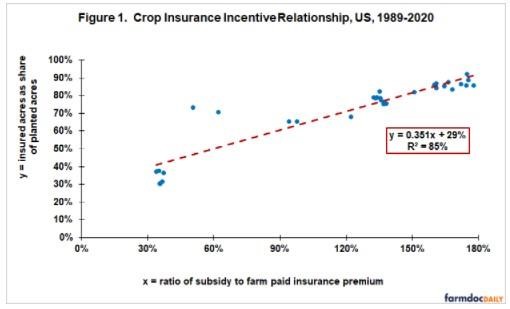By Carl Zulauf
Department of Agricultural, Environmental and Development Economics
Ohio State University
Gary Schnitkey
Department of Agricultural and Consumer Economics
University of Illinois
Cover crops are a topic of considerable interest and debate. Supporters view them as a crop practice that sequesters carbon and improves soil health and water quality. Current evidence largely suggests cover crops do not raise yields or returns in the first years of adoption. It is unclear if they will raise returns or lower risk over time. Adoption of a practice requires an incentive. Public subsidies will thus be needed to encourage the planting of cover crops. The subsidy will have to pay planting cost and provide a practice incentive. US policy experience with crop insurance is used to provide perspective on practice incentive subsides.
Cover Crops and Crop Return / Risk
It is unclear at present if cover crops improve return or lower risk. For example, Illinois farm data for 2016-2020 suggest yields are not higher after cover crops and may be lower. Most of these farmers have planted cover crops for only a few years. Over time, cover crops are hypothesized to improve soil properties, including water retention, and thus may reduce drought yield loss. However, since US crop weather has generally been benign in recent years, the hypothesis awaits a test year. Compounding interpretation of existing studies is the wide variability in findings, which is not unexpected given the variability of farms, farmers, land, and agroclimates,
Lack of clear evidence of higher return or lower risk means public subsidies will have to be paid to incentivize the planting of cover crops. Subsidies will have to provide a practice incentive beyond paying for the cost of the practice, a policy implication supported by the history of crop insurance.
Crop Insurance Practice Incentive
Since 1980, the US has pursued a policy of providing public subsidies to encourage farms to use crop insurance. Congress raised subsidies several times as it searched for a subsidy sufficient to generate wide use of crop insurance (for more discussion, see Zulauf, et al., March 15, 2018 farmdoc daily). This policy experience can be summarized as a practice incentive relationship between the ratio of insured to planted acres for barley, corn, cotton, oats, peanuts, rice, sorghum, soybeans, and wheat and the ratio of premium subsidy to premium paid by farms to insure these crops. The first ratio measures the adoption of crop insurance relative to acres planted. The second ratio measures insurance the practice incentive (i.e. subsidy) relative to the cost farms paid to insure these crops. These 9 crops have received premium subsidies since at least 1989. The ratios are calculated using data from USDA (US Department of Agriculture), Risk Management Agency (2022) and USDA, NASS (National Agricultural Statistics Service) (2022) for the 1989-2020 crop years.
Regression analysis finds a strong, 99.9% statistically significant relationship (see Figure 1). The ratio of premium subsidy to farm paid premium explains 85% of year-to-year variation in the ratio of insured to planted acres. Over the available data, the relationship is linear. Every 10 percentage point increase in the premium subsidy-to-farm paid premium ratio is associated with a 3.48 percentage point increase in the insured-to-planted acre ratio. The relationship suggests that, at no subsidy, insured acres would be 29% of planted acres. This estimated intercept is significant at 99.9% statistical confidence and is consistent with crop insurance reducing the risk of low returns. Reducing risk has economic value, particularly for risk averse farmers and farms in high risk production areas.
Cover Crop Planting Cost
The relationship in Figure 1 is based on knowing the cost to use a practice. Cost of crop insurance to a farm is the policy premium paid by the farm (total premium minus premium subsidy). Cost of a cover crop to a farm is at least the planting cost of seed, equipment, and labor. This cost presumes no change in pesticide program or in row crop yield, experiences generally consistent with cover crops planted into corn stubble moving into soybeans. If adoption of a cover crop lowers yields or increases use of pesticides, our estimate of practice cost would be low.

From the 2017 Census of US Agriculture, average US cost of cover crop seed is $17/acre (see Figure 2). It varies by seed mix. From the Illinois cover crop budget, equipment cost is $15/acre. It varies by seeding method. We assign a labor cost of $5/acre, but it is a guess. With modern equipment, planting an acre requires little labor. But, cover crops are often planted during harvest season when a farmer’s opportunity cost of time is high. Delayed harvest increases crop loss, drying cost, and maybe quality loss. Total planting cost is estimated to be $37/acre. This estimate should be viewed as the average of the distribution of cover crop planting cost.

A subsidy of less than $37/acre provides no practice incentive, which would likely notably dampen the planting of cover crops. A $50/acre subsidy is commonly mentioned in discussions of cover crops. It is similar to the $54/acre average subsidy provided by the state of Maryland. Maryland had the highest share of cropland in cover crops in the 2017 Census of Agriculture (Zulauf and Brown, July 24, 2019 farmdoc daily). A $50/acre subsidy provides a cover crop practice incentive of $13/acre and a return of 35% relative to cover crop practice cost ($13/$37).
Cover Crop Incentive Relationship
At present, the incentive relationship for cover crops is not likely to be the same as for crop insurance. In particular, given the inconclusive evidence at present on whether cover crops reduce risk, the intercept of the incentive relationship is likely to be close to zero. In other words, with no subsidy, little use of cover crop is likely at the present time. The expected intercept would increase if cover crops are found to reduce risk.
The practice incentive relationship for crop insurance does clearly suggest that the subsidy needed to obtain a large planting of cover crops will need to be sizable and will need to increase as the target acres of cover crops increase.
One last issue in estimating cover crop acres is the uncertainty that surrounds the number of potentially feasible cover crop acres. Unanswered questions include, “With what rotations and before and after what crops do cover crops work best and fail to work?” and “How close to the onset of winter can cover crops be planted and consistently provide benefits?”
Summary Observations
An incentive is needed to adopt a practice.
Current evidence is unclear whether cover crops improve return or lower risk for subsequent crops.
A subsidy will thus be needed to encourage farmers to plant cover crops.
The subsidy will need to cover practice cost and provide a practice incentive.
For cover crops, practice cost is at least the planting cost of seed, equipment, and labor. We estimate that it averages at least $37/acre as of 2021. It will vary by farm, farmer, land, and agroclimate.
It is not clear what the practice incentive relationship curve is for cover crops.
The policy experience with crop insurance suggests the cover crop practice incentive will need to be sizable and will need to increase as the targeted share of acres planted to cover crops increases.
The policy experience with crop insurance also suggests Congress will likely revisit the cover crop practice subsidy issue several times before settling on a subsidy with which it is comfortable.
Cover crop policy can be improved by improving estimates of cover crop planting cost and the cover crop incentive relationship curve, as well as by improving the understanding of how these two policy inputs are impacted by farm, farmer, land, and agroclimate characteristics.
The importance of these unanswered questions implies that good cover crop policy also requires funding an extensive research program to answer with clarity the outstanding questions.
Source : illinois.edu